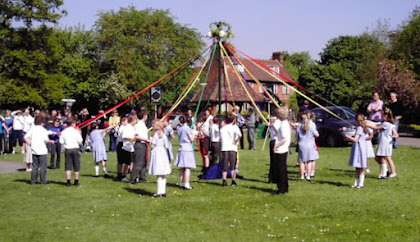The Maypole

Maypole dancing is a custom on May Day. It is accepted to have begun in Roman England close to quite a while back when warriors praised the appearance of spring by moving around enhanced trees saying thanks to their goddess Greenery. Nowadays artists weave strips around a post instead of a tree... The English May Day custom of moving around a maypole is around 600 years of age and the movement frequently unites networks. Generally the artists position themselves two by two of young men and young ladies prior to starting their daily schedule.
The dance makes a multi-shaded design that creeps consistently down the post. The artists then invert their moves toward fix the strips. This is said to address the protracting of the days as summer draws near, however the meaning of the actual post isn't exactly known. A few networks have an extremely durable maypole up throughout the entire year on parks and in squares. At Offenham in Worcestershire, an extremely complicated dance routine around the shaft is performed on May Day consistently. The primary recorded case of a maypole dance came during the fourteenth hundred years in Llanidloes, focal Ribs, and the custom is remembered to have come from Ridges and Scotland prior to spreading around the country. Because of the steadily changing strict conventions of the lords and sovereigns of Britain throughout the long term, the maypole was viewed as an enemy of Christian image for a period, straight up to the furthest limit of the nineteenth hundred years. The tallest maypoles in the nation are at Cloister adherent Monkton, North Yorkshire (88 ft), Barwick-in-Elmet, West Yorkshire (86 ft) and Welford-on-Avon, Warwickshire (65 ft).
Altogether different maypole customs exist in different nations. In Austria and Germany, the maypole is known as a 'maibaum', is painted with Bavarian white and blue stripes, and is raised (in some cases by townspeople) in a town. This might be joined by a parade, after which the shaft is enhanced with symbols of neighbourhood organizations and industry. A much lovelier custom exists in the Rhineland and around Cologne. Unmarried men erect birch trees (purchased from nearby foresters) before the places of their darlings, beautified with crepe paper and a red heart shape with the name of the lady inside it.
The women awaken to find the trees outside on the morning of 1 May. There is likewise the entertaining custom of maypole scrambling, which affects individuals attempting to move to the highest point of the post. This likewise predominantly occurs in Germany and Austria. However not generally hung on 1 May, maypole festivities likewise occur in the States, Malta, Scandinavia, Canada and Italy, with Italians utilizing the post to observe Global Specialists Day as well. Dance into May with an exceptionally chosen scope of feasts, ideal for the start of summer,



Comments
Post a Comment